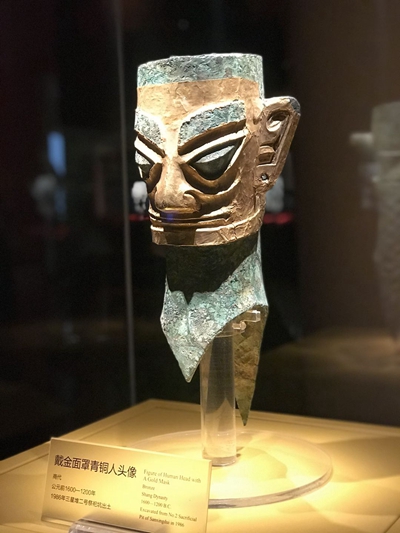Peking University, April 21, 2021: In an afternoon of early spring 1929, a father and son in a village in Guanghan, an outer region of Chengdu in southwest China’s Sichuan province, accidentally unearthed a true wonder of civilization when digging a well. The farmers’ discovery of sacrificial pits containing treasures of bronze, gold, jade and pottery from the ancient Kingdom of Shu provided evidence for an ancient Chinese civilization that extended beyond China’s central plains in 3,000-5,000 years ago. Sanxingdui, also known as Three-star Piles, demonstrated a civilization that had its own customs and rituals, as well as remarkable innovation.

Sichuan province and its capital Chengdu are focal points for the discovery and
research of ancient Chinese civilizations. Some of China’s oldest historical
relics, providing evidence of ancient Chinese crafts, customs and practices,
have been found in the region. Modern Chengdu and surrounding areas are a
melting pot of culture and customs inherited from ancient times: taxi drivers
recite the works of Tang Dynasty (618-907) poet, Du Fu; the relics of the
Sanxingdui historical site; elderly retirees in public parks playing mahjong
over cups of tea; the ancient rock carvings of Dazu caves; Chengdu’s famed
bianlian (face-changing) performance, where performers change masks faster than
audiences can follow. Each has its roots in ancient Chinese civilization or
dynastic rituals, and each demonstrates the strong effect ancient civilization
has on contemporary Sichuanese culture.
The Bronze Age civilization discovered at Sanxingdui is one of the earliest
civilizations discovered in China, but is just one of several Chinese
civilizations that existed at the time. The farmers’ discovery of the
sacrificial pits and the treasures they contained aroused significant
archaeological and scholarly interest. The artifacts were identified as
belonging to the ancient Kingdom of Shu, which existed over 3,000 years ago, or
around a thousand years before the Terracotta Army was built in Xi’an, capital
of northwest China’s Shaanxi province.
This discovery provided strong evidence for the hypothesis put forward by many
archeologists that Chinese civilization is descended from multiple centers of
ancient innovation. This theory is further reinforced by the fact that many of
the walls surrounding settlements of the ancient Baodun culture, located close
to the Sanxingdui archeological site in Sichuan province, had similar methods
of construction to those of the Shijiahe culture, located over a thousand
kilometers away in what is now Tianmen, central China’s Hubei province. The
artifacts, however, are unlike anything others discovered in other parts of
China. The styles of the artifacts, for example bronze heads with bulging eyes,
were previously unseen in China’s history, and the next known example of human
statuary crafting does not appear on the archeological record for nearly a
millennium. These facts reinforce the uniqueness of the artifacts and the
civilization that produced them. Little is known of their makers, who they
were, and whether they spoke a form of Chinese, or a language closer to Burmese
or Thai.
The ancient nature of these discoveries, as well as the lack of accompanying
historical records, creates difficulties in deducing information about the
civilization that created them. Nevertheless, artifacts discovered at the
Sanxingdui site do provide clues that can help historians speculate about the
origins of Chinese civilization. For example, the technical quality and
artistic style of the artifacts are suggestive of an advanced civilization. The
bronze figures found at the site include a tree that is more than 13 feet in
height, a statue of a man that stands at over eight feet, and over 50 bronze
heads. The purpose of these artifacts remains ambiguous, leaving space for
historians to speculate about their intended uses. In addition to daily
utensils, there were many animal sculptures, perhaps used as children’s toys,
and many jade jewelry pieces including beads, which are presumed to have been
worn as accessories. We can also draw conclusions from other relics to gain a
wider picture of Chinese society of that time. For example, pottery vessels
that were immediately buried with food stored inside demonstrate an ancient
understanding of refrigeration.
Artefacts of ritual and worship are equally fascinating, with the bronze trees
found at Sanxingdui providing insights into how ancient Chinese civilizations
connected their own world with the world of the supernatural. The trees are
believed to have been regarded as an axis between the earthly world and the
heavenly world. Rather than household ornaments then, these bronze trees can be
considered mystical religious relics.
Archeological discoveries in Sichuan province play an important role in tracing
the emergence of Chinese civilization. Being naturally fertile, the area
attracted early settlers, and from sites such as Sanxingdui, archeologists and
historians can discover much about the innovative, spiritual and practical
nature of these early peoples. The mysteries of the Sanxingdui relics support
the idea that the more one knows about Chinese civilization, the more difficult
it becomes to grasp its complexities and nuances. The discoveries of ancient
Sichuan both aid and perplex our understanding of Chinese civilization.
The author is Natasha Lock, a Yenching Academy scholar of Peking University
from the UK.
Source: Beijing Review